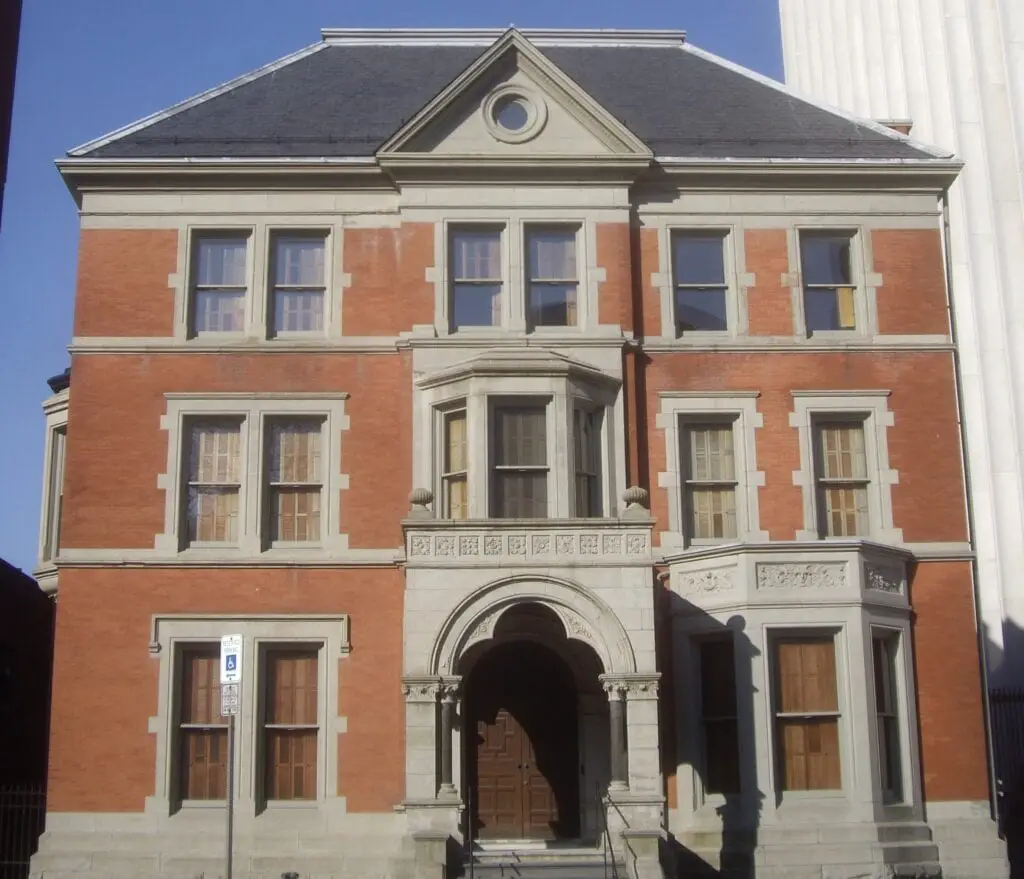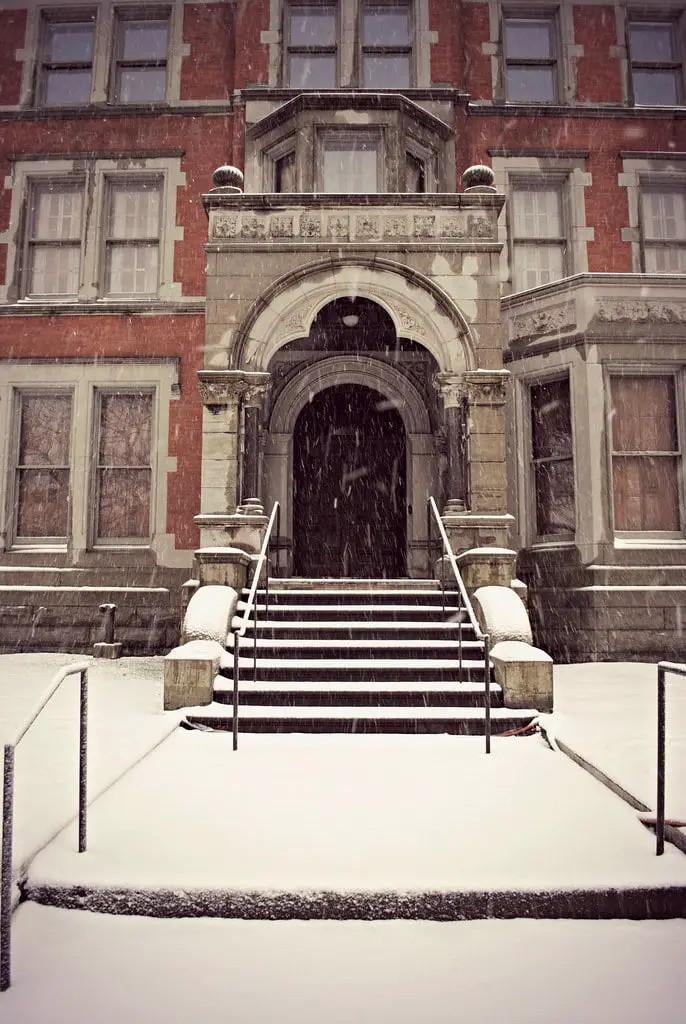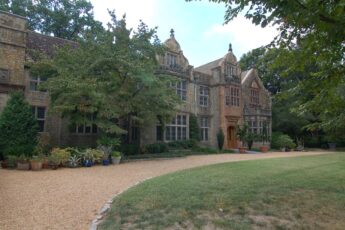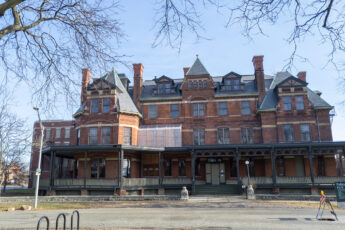The Architectural Marvel of 1885
In the heart of Newark, NJ, stands a testament to Victorian grandeur: the John Ballantine House. Built in 1885, this landmark whispers tales of a bygone era, echoing the opulence that once defined America’s Gilded Age.
George Edward Harney, a name synonymous with architectural elegance, lent his vision to create this masterpiece. His design, a blend of art and architecture, turned bricks and mortar into a canvas of high Victorian style.
The house’s exterior, a symphony in salmon-colored Philadelphia pressed brick, catches the eye from blocks away. Sandstone trim adds a touch of sophistication, framing the structure’s asymmetrical beauty. Each detail, from the intricate lintels above the sash windows to the Corinthian capitals crowning the granite columns, speaks of a time when craftsmanship reigned supreme.
Step inside, and the past envelops you. The New York firm D. S. Hess Company, renowned for their “decorators and manufacturers of artistic furniture,” transformed these rooms into a Victorian dream.
Imagine dining beneath part-gilded embossed panels, surrounded by the luxury of the era’s finest materials. This was not merely a house but a statement of wealth, taste, and cultural standing.
The John Ballantine House now serves as a bridge to Newark’s storied past, inviting visitors to explore its halls and history.
As a piece of the James Street Commons Historic District, it is the last of its kind, a solitary reminder of the grand houses that once lined the park.
Its designation as a National Historic Landmark in 1985 cements its place in American history, ensuring that future generations can wander its rooms and wonder at its grandeur.
For those seeking things to do in Newark, NJ, the John Ballantine House offers a unique glimpse into the city’s rich cultural tapestry.
It’s more than a museum; it’s a journey back in time, a chance to walk in the footsteps of the Ballantine family and experience the luxury of 19th-century life. The house’s story is Newark’s story, a tale of beauty, industry, and enduring legacy.
The Ballantine Legacy
The story of the Ballantine family intertwines with the fabric of Newark’s history. The patriarch, Peter Ballantine, laid the foundation of this legacy in 1840 when he established the Ballantine beer brewery.
This wasn’t just a business but a cornerstone for Newark’s industrial growth and a symbol of American entrepreneurship.
In 1883, John Holme Ballantine took over the family business, steering it through the bustling economic currents of the time. Under his leadership, the brewery flourished, becoming synonymous with quality and innovation.
However, John’s ambitions went beyond beer; he envisioned a home reflecting his family’s status and success. Thus, the John Ballantine House became a physical manifestation of the family’s achievements and aspirations.
The Ballantine family’s narrative is a tapestry of triumph and tragedy. They lived lives of philanthropy and social prominence, contributing to Newark’s cultural and social spheres.
Yet, they were not strangers to sorrow. John’s death in 1895 marked the end of an era, but the family’s legacy continued to influence Newark and its citizens.
The house remained in the family until 1920, a beacon of the city’s Victorian past amidst the waves of modern change.

A Museum Reborn
In 1937, a new chapter began for the John Ballantine House as it transitioned from a private residence to a public museum. This transformation marked a significant moment for Newark’s cultural landscape.
The Newark Museum, recognizing the house’s historical and architectural value, undertook its stewardship, opening the doors to a world where history and art converge.
The museum’s dedication to preserving the house’s legacy is evident in its meticulous restoration efforts.
In the 1990s, a major renovation breathed new life into the aging structure, ensuring that every detail, from the ornate woodwork to the historic wallpapers, was preserved or faithfully recreated.
This wasn’t just a renovation; it was a resurrection, allowing visitors to step back in time and experience the grandeur of the Victorian era.
But the museum didn’t stop at restoration. They reimagined the house as a vibrant cultural hub, integrating contemporary art exhibitions with historical displays.
The Christmas season sees the house adorned in traditional Victorian decorations, a festive nod to its past.
Yet, the year-round exhibitions truly showcase the museum’s commitment to connecting the past with the present.
From showcasing Newark’s industrial heritage to hosting contemporary art installations, the museum ensures that the Ballantine House remains a relevant and engaging part of the city’s cultural fabric.

Contemporary Connections
The Ballantine House stands as a bridge between the past and the present. It is fascinating to see how the Newark Museum has infused contemporary relevance into this historic setting.
The house now hosts an array of modern art installations, creating a dialogue between the old and the new.
This blend enriches the visitor experience, offering fresh perspectives and deeper insights into Newark’s evolving cultural landscape.
“Made in Newark” is one such exhibit that caught my attention. It highlights the city’s vibrant arts scene, featuring works by local artists and artisans.
This installation not only celebrates Newark’s creative spirit but also fosters a sense of community pride.
The Listening Lounge, another innovative feature, offers a musical journey through the city’s rich auditory history, from jazz to contemporary beats.
The integration of contemporary art within the walls of the Ballantine House challenges visitors to reflect on the passage of time and the continuity of creativity.
It’s a testament to Newark’s resilience and dynamism, proving that the city’s cultural flame burns as brightly today as it did in the past.
Challenges and Criticisms
Every historic site faces its share of challenges, and the Ballantine House is no exception. Balancing the act of preservation with modernization is a tightrope walk.
The house must maintain its historical integrity while meeting the needs of today’s visitors. This is no small feat, considering the technological and accessibility standards of the 21st century.
Financial constraints add another layer of complexity to the preservation efforts. Restoring and maintaining a Victorian mansion requires significant resources.

Securing funding and managing the house’s upkeep demand constant attention and innovative solutions.
The Newark Museum has been proactive in this regard, engaging the community and seeking grants to support their mission.
Addressing these challenges requires a collaborative approach. Partnerships with local businesses, educational institutions, and cultural organizations can provide the support needed to keep the Ballantine House vibrant and accessible.
Community involvement is crucial; after all, this historic house is a shared treasure, reflecting the collective history and aspirations of Newark’s residents.
The Ballantine House in Popular Culture
The Ballantine House has made its mark beyond the realms of history and architecture; it’s a cultural icon in its own right.
I’ve seen it featured in various media, and each portrayal adds a layer to its mystique. It’s not just a backdrop but a character that embodies Newark’s spirit and history.
This mansion has inspired authors and filmmakers alike, serving as a setting for stories that span genres and eras.
Educational programs have also found a home here. The house serves as a real-world classroom for students of all ages, offering lessons in history, art, and architecture. It’s a tangible connection to the past, making history accessible and engaging.
The museum’s efforts to integrate the house into Newark’s educational landscape are commendable, providing a valuable resource for teachers and students alike.
The mansion also doubles as an event venue, hosting everything from elegant weddings to corporate gatherings.
This brings in revenue for its upkeep and allows more people to experience its grandeur firsthand. Each event held within its walls adds to the house’s ongoing story, blending the past with the present.

Visiting the Ballantine House
If you’re looking for things to do in Newark, NJ, the Ballantine House should be on your list. Planning a visit is straightforward. The Newark Museum offers tours that delve into the house’s history and significance.
Check their website for tour schedules and ticket information. They often host special events and exhibitions, so there’s always something new to discover.
Virtual tours are available for those who can’t visit in person. These online experiences offer a glimpse into the mansion’s beauty and history from anywhere in the world. It’s a fantastic way to explore the house if you’re unable to travel to Newark.
While in the area, explore more of Newark’s rich history, culture, and art. From the vibrant Ironbound district to the serene Branch Brook Park, there’s much to see and do. The Ballantine House is just the beginning of Newark’s treasures waiting to be explored.








